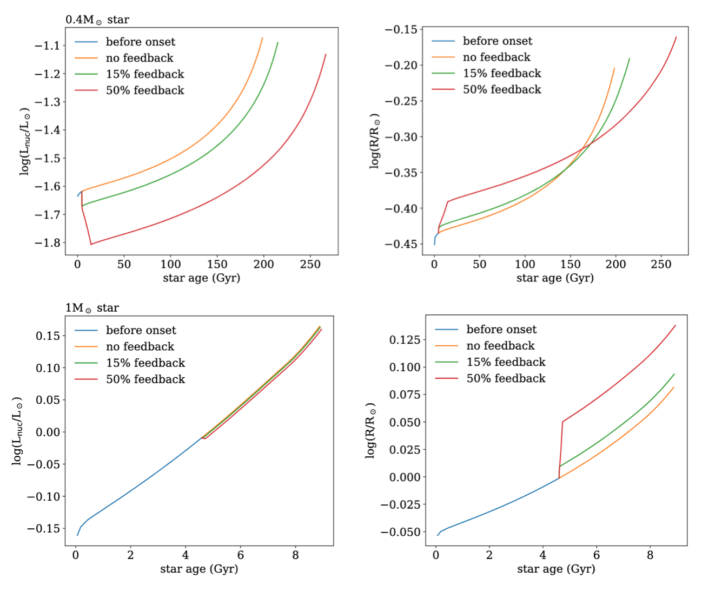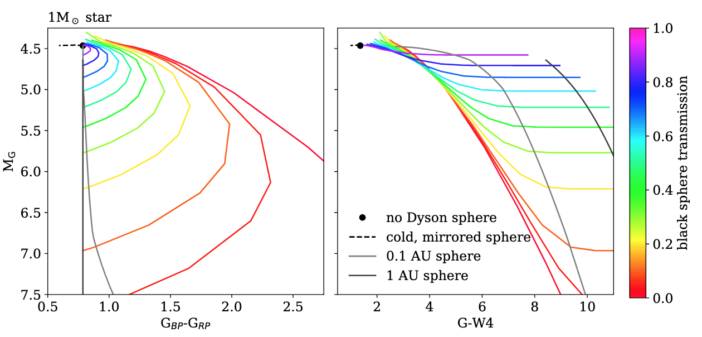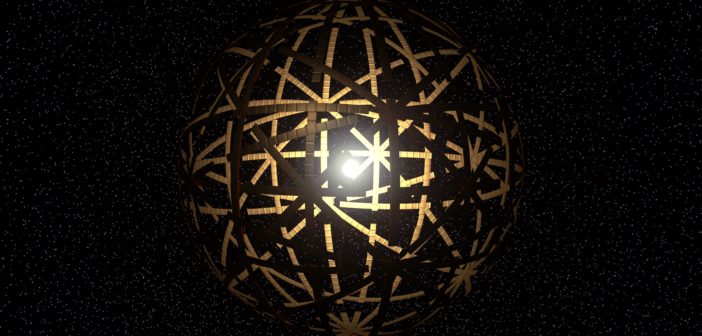Editor’s note: Astrobites is a graduate-student-run organization that digests astrophysical literature for undergraduate students. As part of the partnership between the AAS and astrobites, we occasionally repost astrobites content here at AAS Nova. We hope you enjoy this post from astrobites; the original can be viewed at astrobites.org.
Title: Evolutionary and Observational Consequences of Dyson Sphere Feedback
Authors: Macy Huston and Jason Wright
First Author’s Institution: The Pennsylvania State University
Status: Published in ApJ
Are we truly alone? Or rather, where is everybody? After all, there are many billions of stars and exoplanets in the Milky Way, and our galaxy has had billions of years to evolve. Although the search for extraterrestrial life has so far yielded nothing, we may still be able to detect signs of past or present intelligent life within our galaxy by detecting artificial megastructures.
Technosignatures
In order for a civilisation to make the technological leap to conquer the stars, it must be able to acquire and harness sufficient energy. This is the basis of the Kardeshev scale, which ranks technological advancement based on energy utilisation. One way to harness a massive amount of energy is to partially or even fully surround a star with solar panels or solar collectors. This type of megastructure is known as a Dyson sphere, named after physicist Freeman Dyson who proposed it as a thought experiment, arguing that such megastructures were a logical next step to meet the energy needs of a space-faring civilisation. Dyson postulated that it may be possible to detect the presence of megastructures by looking for changes in a star’s electromagnetic spectrum. A change in a measurable property, like a star’s spectrum, due to the presence of some artificial structure is referred to as a technosignature. So, what is the technosignature of a Dyson sphere?
So far, studies have mostly focused on changes to the spectrum of the star — particularly in the infrared — and/or light dimming as the megastructure rotates around the star. However, there is a more subtle effect at play too: the radiative feedback from the Dyson sphere itself. Today’s article examines this feedback and the subsequent effects on the star’s evolution, and whether such effects constitute a detectable technosignature.
Feedback
The goal of a Dyson sphere is to collect as much energy as possible from a star, but it is likely that some of this energy will be reflected back onto the star. Additionally, the material of the Dyson sphere will ultimately heat up and emit thermal radiation. As such, Dyson proposed conducting observations in the infrared to try to detect this heat signature. We can gain further insight into this signature by understanding how the star behaves when it is subjected to Dyson sphere feedback. The authors of today’s article use the open-source Modules for Experiments in Stellar Astrophysics (MESA) tool to simulate the evolution of a star subject to external irradiation — in this case, the radiative feedback from the surrounding Dyson sphere. The authors simulate several stars with different masses and with different degrees of feedback, modelled as the fraction of the star’s luminosity that is reflected back.
As seen in Figure 1, feedback from the Dyson sphere generally results in a decrease in nuclear luminosity (the rate of energy production due to nuclear fusion) and an increase in radius. In other words, the star cools and expands. The effect is considerably more pronounced for the 0.4-solar-mass star as it is primarily convective (energy transfer is dominated by convection), whereas the 1-solar-mass star is mostly radiative with only a small outer convection layer. The drop in luminosity also means that the star lasts longer on the main sequence before exhausting its supply of hydrogen.

Figure 1: The nuclear luminosity (left panels) and stellar radius (right panels) as a function of the age of the star for a 0.4 solar mass star (top row) and 1 solar mass star (bottom row). Different coloured lines correspond to different levels of Dyson sphere feedback, with the blue line corresponding to the star before the construction of the megastructure. [Adapted from Huston & Wright 2022]
Dyson Sphere Program
The feedback from Dyson spheres is thus able to change the properties of the host star, with more substantial changes occurring in low-mass stars. How does this translate into observations? To find out, the authors use the AGENT formalism, which characterises a Dyson sphere with five parameters. These include the power of the intercepted starlight, denoted α, and the characteristic temperature of the waste heat, T. The authors consider two types of Dyson spheres: hot Dyson spheres, which are coloured black and absorb all starlight, and cold, mirrored Dyson spheres, which reflect all starlight without heating up.
In Figure 2, we see mock colour–magnitude diagrams for two instruments, ESA’s Gaia spacecraft and NASA’s WISE spacecraft. GBP, GRP and G-W4 refer to the blue and red Gaia filters and the infrared WISE filter, respectively. At high feedback levels, the temperature of the sphere is close to that of the star, so it appears bluer. At low feedback levels, the Dyson sphere is cooler and contributes to the dimming and reddening of the star. For cold, mirrored spheres, the reflected light makes the star appear bluer, but its overall luminosity is unchanged.

Figure 2: Colour–magnitude diagrams for potential Dyson spheres systems around a 1 solar mass star for Gaia observations (left panel) and WISE observations (right panel). Coloured lines denote different fractions of feedback, with the black lines denoting Dyson spheres at 0.1 au and 1 au. [Adapted from Huston & Wright 2022]
To Change a Star
Low-mass stars are significantly affected by Dyson sphere feedback; only 1.3% feedback is required to alter the nuclear luminosity of a 0.4-solar-mass star by 1%, while 45% feedback is required to produce the same change in a solar-mass star. In general, the Dyson spheres themselves must also have extremely high temperatures in order to generate sufficient feedback. Figure 3 shows that even low-mass stars would require temperatures well in excess of 1000K to result in even a slight change of nuclear luminosity. There is no significant change in nuclear luminosity for Dyson spheres with temperatures in the hundreds of kelvin.

Figure 3: The fraction of captured starlight versus the effective temperature (in Kelvin, K) of the Dyson sphere. Solid lines correspond to the values required for a 1% change in nuclear luminosity, and dotted lines correspond to a 1% change in the effective temperature of the star. [Huston & Wright 2022]
Astroengineering
This study has demonstrated that in extreme cases, the feedback from Dyson spheres can directly influence a star’s evolution: it cools, reddens, expands, and its lifetime on the main sequence is extended. The authors suggest that advanced civilisations could therefore use Dyson spheres as part of stellar engineering projects to extend a star’s life or siphon material (star lifting). The search for technosignatures has ramped up in recent years thanks to improvements in instrumentation. Modern instruments are sensitive enough to measure a star’s light dimming, most notably in Boyajian’s star, where one explanation proposed for its unusual light fluctuations is a transiting megastructure. Today’s article shows that Dyson spheres can result in measurable changes to stellar properties. Megastructures have long been confined to science fiction, imagination, and certain video games. However, if there are indeed Dyson spheres out there waiting to be found, we could soon be in a position to find them.
Original astrobite edited by Luna Zagorac.
About the author, Mitchell Cavanagh:
Mitchell is a PhD student in astrophysics at the University of Western Australia. His research is focused on the applications of machine learning to the study of galaxy formation and evolution. Outside of research, he is an avid bookworm and enjoys gaming, languages, and code jams.
